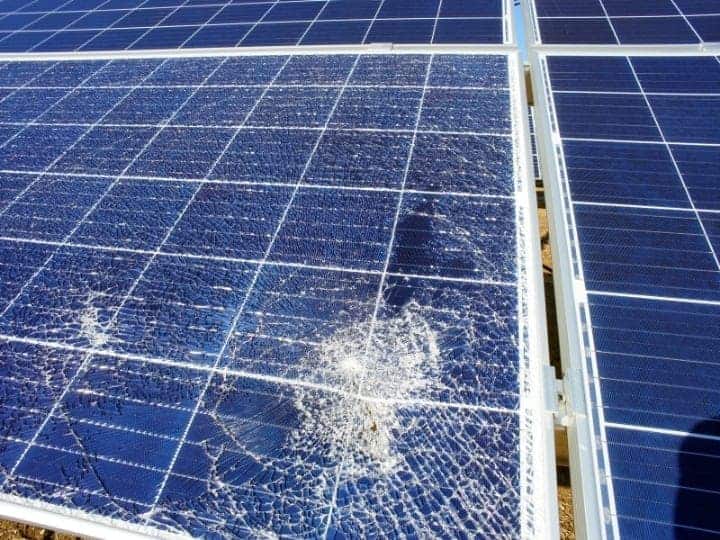When something is cracked, it’s usually useless, although it no’s not always the case. Most people aren’t sure how to respond whenever they discover a broken solar panel.
Will a panel still work even if it’s been cracked?
Most solar cells will continue to produce a current even after they’ve been cracked. This current should still be usable, but your panel won’t operate at maximum voltage.
There are damage variations and decisions to make. Here’s what we will look at today;
- Cracked Produce Electricity
- Use a Cracked Panel
- Panels That Are Nonfunctional
- Using a Cracked Panels Dangers
- Replacing a Broken Panels

Will a Cracked Solar Panel Still Work?
Spotting a crack on your solar panel might send you into a spiral if you just purchased them. Fortunately, most cracks won’t impede your panel’s performance.
A more severe crack could reduce its overall output. Minor cracks might not make any difference at all. Modern solar panels tend to be built with a protective casing. These cover all of their vulnerable electronic components.
Sometimes, the exterior casing might be cranked, and there’s no interior damage. If that’s the case, then you’ve got something purely cosmetic on your hands.
Cracked Panels Can Still Produce High Voltages
Cracked panels work if we define a working panel as one that produces a current. At least most of the time, cracks don’t damage the solar cells themselves.
These cells are among a solar panel array’s most critical components.
Even if a solar cell has been damaged, that doesn’t compromise the entire panel. Panel performance drops in proportion to the total amount of damage.
For example, 10 to 20% of your solar cells have been broken. Then, you’d expect a 10 to 20% drop in your panel’s peak voltage.
See also: Solar Panels Maintenance: Essential Tips for Optimizing Efficiency and Longevity
Damaged Cells Can Produce Current But Less Efficient
Reduced power output isn’t a dealbreaker for most people. As long as they continue to produce enough for your needs, why would you care whether they’ve been cracked?
The most significant consideration would be how the crack might’ve compromised the panel’s safety. Water and electricity pose a safety hazard when they are mixed.
Those cracks could be the perfect spot for water to seep inside your panels.
Depending on how those panels have been built, that could be a considerable risk. Most modern panels are relatively resistant to environmental conditions.
But, you should still have them inspected if you’ve got any concerns. That’s the easiest way to determine if they’re still safe for you to use.
Testing a Panel’s Power Output Using a Voltmeter
Using a voltmeter to test your solar panels’ output is a quick way to see whether they’re working. Voltmeters detect the flow of electricity.
By touching the prods to the panels’ terminals, they’ll show you how many volts your panels produce.
You have a dead panel on your hands if there isn’t any current. Compare how much you see on your voltmeter with the manufacturer’s specifications.
Most panels don’t produce maximum voltage, even if they’re fresh out of the box.
However, a new panel should produce 95% or more of its max-rated power output. That is, assuming it’s in direct sunlight. If you see much less than that, your panel’s performance might’ve been compromised.

What Should You Do When You Find a Cracked or Broken Panel?
First, take a close look at the affected area. You are spotting what looks like a crack on your solar panel doesn’t mean much if you saw it while standing on the curb.
Get close to the panels, and take some close-up photos of the damage.
Cosmetic damages shouldn’t be a cause of concern. But, if it seems like more than a surface scratch, you might want to consider replacing it.
Should You Replace It?
Do you know what your net energy production is each month? If you’ve been producing 200 kWh but only use 100 kWh each month, losing a little output isn’t a big deal.
If there aren’t safety concerns, you could continue using them.
On the other hand, let’s say that you produce 200 kWh while using 185 kWh each month. In that case, you can’t afford to lose much of your output. Replacing a panel might make more sense, then.

How You Can Maximize Your Panels’ Lifespan
When purchasing your panels, pay close attention to where you’d like to place them. Anything above your panels might pose a potential risk.
Imagine there is a tree with branches hanging above your home.
During the storm, one of those branches could be blown down into your panels. We’d suggest cutting the tree down before installing the panels in that case.
Beyond panel placement, maintenance would be the next biggest thing under your control. Properly maintaining your panels can extend their lifespan by quite a bit.
Have a certified technician inspects them at least once a year.
They’ll be a lot more likely to spot anything of concern and catch it early. Repairing a minor cosmetic scuff could prevent some real damage.
Broken Cells Cannot Be Fixed
Why does solar panel maintenance matter so much? Well, once a panel has been broken, replacing them is not usually possible. Your solar cells’ housing Is one thing. However, damage to solar cells is fatal for your panel.
Sources:
- https://www.energy.gov/eere/solar/how-does-solar-work
- https://www.energy.gov/eere/solar/how-does-solar-work#pvbasics
- https://www.sunengis.com/is-there-a-way-to-fix-a-cracked-solar-panel/
- https://www.energy.gov/eere/solar/solar-photovoltaic-system-design-basics
- https://www.energy.gov/eere/solar/solar-performance-and-efficiency



